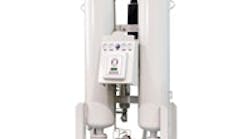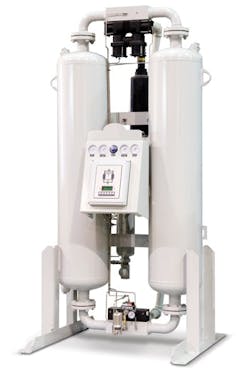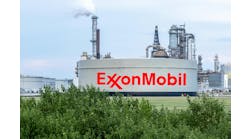Deter Difficulties with Desiccant Dryers
When facilitating the "Study Your Supply Side" section of the "Fundamentals of Compressed Air Systems" workshop of the Compressed Air Challenge (www.compressedairchallenge.org), I always point out that that there's more to a successful and efficient dryer installation than just sizing the unit properly. For example, it's important to understand what can happen in the piping upstream of the dryers and how to reduce their operating costs. Also, if dryers will be installed in parallel, knowing how to maintain a balanced flow across them is essential. Simply paralleling dryer packages is no guarantee the air flows will balance equally. Differences in the pressure drop across filters, piping and even the dryers themselves can cause unbalanced flow that can overload dryers. So, here, we'll look at examples of some problems.
But first, let's consider what happens in the piping upstream of the dryers:
• The moisture content of the air doubles with every 20°F rise in temperature at the discharge of the compressor.
• Oil carryover increases as the operating temperature of a lubricated compressor goes up.
• In most cases the air leaving the compressor's after-cooler is saturated.
• When the ambient temperature is lower than the pressure dew point temperature of the compressed air, the compressed air will cool as it travels along the pipe and condensate will form.
• The larger the temperature differential is between the compressed air pressure dew point temperature and the ambient temperature, the larger the volume of condensate.
• The longer the piping is between the compressor and dryer, the more the compressed air cools, boosting the volume of condensate created.
• Moisture and oil in vapor form will pass through filters.
• Coalescing filters prefer water over oil.
• Slugging a coalescing filter element with large volumes of condensate increases the wet band in the filter element, causing the velocity of the air flowing through the filter element to rise, which results in condensate carryover and, if the slugs are large enough, the drain may not be able to remove the condensate before some of it carries over. Slugging also can damage the filter element.
• Mist eliminators can handle slugs of condensate; however, like any other filter, if overloaded, they will allow condensate to pass through.
• Failing to drain the filter housing often enough or for a sufficient duration results in condensate carryover. It's crucial to maintain condensate drains because they're the weakest link in the cleanup process.
• Installing a pre-cooler and moisture separator ahead of a desiccant dryer can prevent condensate formation or reduce the amount created and may save energy.
These points are important in troubleshooting problems and ensuring that desiccant dryers are installed so they will deliver air at their rated pressure dew point and achieve their expected desiccant life.
DISAPPOINTING DEW POINT
A few years ago a plant in Texas installed a new 2,600-scfm heated blower purge desiccant dryer equipped with energy savings controls downstream of air-cooled lubricated rotary screw compressors. The compressed air equipment was placed outdoors, which is common in that part of the country. The dryer was sized for a peak flow of 1,635 scfm at inlet conditions of 115°F at 95 psi. A mist eliminator filter was installed upstream of the dryer's pre-filter and an air-to-water heat exchanger was installed downstream of the dryer to eliminate the temperature spike that sometimes occurs at switchover. Yet, even with all these precautions, the dryer only produced a -20°F pressure dew point instead of its rated -40°F level. So, we were asked to determine why.
The ambient conditions were 95°F and 60% relative humidity, while the compressors' discharge temperature was 117°F and the dryer inlet temperature was 107°F. It was apparent that the coolers on the compressors needed to be cleaned. However, the temperature at the dryer's inlet was less than 115°F — so why wasn't the dryer meeting its -40°F pressure dew point target?
At a discharge temperature of 117°F, almost all the atmospheric moisture taken in by each compressor was leaving it in vapor form, along with oil vapor picked up as the air flowed through the unit. In other words, the moisture separator wasn't removing much, if any, condensate. The "no air loss" drains installed on the filters showed us that condensate was forming in the piping upstream of both the mist eliminator and the dryer pre-filter. Opening a drain valve between the pre-filter and the dryer proved that condensate was either condensing downstream of the pre-filter or passing through it and then flowing into the dryer and contaminating the desiccant.
After reviewing the options, personnel moved the air-to-water heat exchanger from downstream of the dryer to upstream of the mist eliminator and installed a moisture separator with a "no air loss" drain. The 87°F cooling tower water lowered the air's temperature to below ambient, which stopped condensate from forming in the piping; after personnel replaced the desiccant in the dryer, it began drying the air to a -40°F pressure dew point. Installing the heat exchanger upstream of the dryer also reduced the dryer's operating cost because the energy controls cut back the dryer heater energy and decreased the average purge air flow rate.
Installing a pre-cooler upstream of a heated desiccant dryer equipped with energy saving controls will reduce the energy required to operate the dryer in proportion to the amount of moisture the pre-cooler removes. It also extends the life of the desiccant. Types of pre-coolers include air-to-air or air-to-water heat exchangers as well as refrigerated air dryers. Refrigerated dryers, although not suited for all environments, also can serve in some cases as a temporary backup to the desiccant dryer. Note that installing a pre-cooler upstream of a "heatless" desiccant dryer (Figure 1) equipped with energy savings controls may improve its performance but doesn't provide significant energy savings.
WINTER WOES
A paper mill in the Carolinas had a similar problem with two of its "heatless" desiccant dryers — but this time the problem occurred during the winter. The plant had water-cooled compressors along with a wet receiver and two dryers that were installed outside, where the ambient temperature was 31°F. The discharge temperature of the compressors feeding the first dryer was 88°F but the dryer inlet temperature was only 65°F. As we measured the dryer inlet temperature, the problem became obvious once we spotted a moisture separator installed between the pre-filters and dryer. Excessive condensate collected in the pre-filters because they were installed near the floor; when we removed the pre-filter elements they were swollen from being soaked with condensate. Insulating and heat tracing the piping between the receiver and the inlet of the dryer resolved the problem and allowed removal of the moisture separator. We also recommended insulating the dryer towers to prevent losing the heat of adsorption.
The pre-filter for the second dryer was installed approximately 50 feet ahead of the dryer, providing plenty of distance for condensate to form between it and the dryer. Mounting the pre-filter directly on the inlet of the dryer and installing a wet air receiver just upstream to prevent condensate from slugging it banished that problem.
We see similar problems with desiccant dryers installed outside in plants all along the Gulf Coast where the nighttime temperatures often drop to the 40s or below during the winter months.
UNBALANCED FLOW
Another dryer issue we constantly find is unbalanced flow through paralleled desiccant dryers. One plant stands out because it had flow meters downstream of its two paralleled 2,000-scfm heated split-stream desiccant dryers, enabling us to see the unbalanced flow. The two dryer skids, which included pre-mounted filters, were installed next to one another with similar length piping. So, while they weren't specifically piped in using a balance header arrangement (Figure 2), the piping didn't significantly unbalance the flow. However, as the pressure drop across the dryer filters increased, the instrument air pressure in the plant dropped to an unacceptable level — therefore personnel changed out the filter elements of one dryer. Because that swap raised the downstream pressure sufficiently, they didn't bother to replace the filters in the other dryer. The higher pressure drop across the dryer with the dirty filters diverted most of the flow through the dryer with the clean filter elements until the pressure drop across the paralleled dryers equalized.
This example points out the problem of paralleling dryer skids with pre-mounted pre- and after-filters. If you intend to parallel dryers, purchase them without the filters pre-mounted and then install them as shown in Figure 2. That diagram illustrates a balance header arrangement that equalizes the pressure drop in the piping across the three dryers and their filters. To reduce maintenance and pressure drop, specify each filter at least one or two sizes larger than the combined rated flow of the three dryers. If you plan to remove the filters from existing dryer skids, then install a fourth filter to provide the required redundancy.
Typically, a dryer installation has two pre-filters and two after-filters, with one of each kept in reserve so it's available for use when changing the element in the filter that had been online. From time-to-time, to reduce the pressure drop, personnel may operate all the filters simultaneously. The problem with this approach is that when the pressure drop across the filters is 2 psi and personnel then isolate one filter to change its elements, the pressure drop across the online filter increases to 7 psi. The question is, "Will personnel actually change the filter elements when the pressure drop is only 2 psi? Aren't they more likely to wait until the pressure drop reaches 4 or 5 psi?" If so, when they isolate one of the filters, the pressure drop across the other filter will jump to 14 psi or more.
WORTHWHILE ADDITIONS
Whenever piping between the compressor and air dryer is exposed to ambient temperatures lower than the compressor discharge temperature, consider installing a pre-cooler directly after the compressor, especially for air-cooled units, or use chilled water in the after-cooler on water-cooled ones. Typically, this requires modifying the water piping on a lubricated rotary screw compressor to prevent the chilled water from going through the oil cooler.
If the ambient temperature is lower than the temperature of the air leaving the pre-cooler or after-cooler, then install a mist eliminator, wet air receiver or knockout tank just upstream of the dryer pre-filters and insulate and heat trace the headers between the discharge of the receiver/knockout tank and the inlet of each dryer. A mist eliminator is the preferred option in systems with lubricated compressors, while in systems with "oil free" compressors, the receiver or knockout tank works well.
Remember the performance and life of a desiccant dryer depends upon protecting it from the condensate that can form in the upstream piping. Taking appropriate steps may increase installation costs but the resulting air quality provides a payback in the form of reduced maintenance of compressed air components and, in the case of heated desiccant dryers, significant energy savings.




